Here is Default.aspx
<%@ Page Language="C#" AutoEventWireup="true" CodeFile="Default.aspx.cs" Inherits="_Default" %>
<!DOCTYPE html PUBLIC "-//W3C//DTD XHTML 1.0 Transitional//EN" "http://www.w3.org/TR/xhtml1/DTD/xhtml1-transitional.dtd">
<html xmlns="http://www.w3.org/1999/xhtml">
<head runat="server">
<title></title>
</head>
<body>
<form id="form1" runat="server">
<div>
<asp:Button ID="btnGetAdditionProblem" runat="server" Text="Addition"
onclick="btnGetAdditionProblem_Click" /><br />
<asp:Label ID="lblProblem" runat="server" Text="Label"></asp:Label><br/>
<asp:TextBox ID="txtAnswer" runat="server"></asp:TextBox>
<asp:Button ID="btnCheckAnswer" runat="server" Text="Check"
onclick="btnCheckAnswer_Click" /><br />
<asp:Label ID="lblResult" runat="server" Text="Label"></asp:Label>
</div>
</form>
</body>
</html>
Here is the code behind Default.aspx.cs
using System;
using System.Collections.Generic;
using System.Linq;
using System.Web;
using System.Web.UI;
using System.Web.UI.WebControls;
public partial class _Default : System.Web.UI.Page
{
/*This class does a test for simple addition. It
* also shows how to save a variable to session
* variable so that it is avialable after the postback
* (page redraw from server)
* caused by clicking a button
*/
//class level variables
int number1;
int number2;
int answer;
protected void Page_Load(object sender, EventArgs e)
{
//this event method is used to do anything that needs to
//be done before the page is loaded for the viewer
}
protected void btnGetAdditionProblem_Click(object sender, EventArgs e)
{
//call the addition method when the button is clicked
Addition();
}
protected void GetRandom()
{
//get random numbers
Random rand = new Random();
number1 = rand.Next(0, 10);
number2 = rand.Next(0, 10);
}
protected void Addition()
{
//get the random numbers
GetRandom();
//make the problem visible in a label
lblProblem.Text = number1.ToString() + "+" + number2.ToString();
//assign an answer to the problem
answer = number1 + number2;
//save the answer to a server side Session variable
Session["CurrentAnswer"] = answer;
}
protected void btnCheckAnswer_Click(object sender, EventArgs e)
{
//get the user's answer from a text box
int guess = int.Parse(txtAnswer.Text);
//recall the answer from the server
//the session variable stores everything as "object"
//so you have to cast it back to the type of object
//that it is--in this case an integer
answer = (int)Session["CurrentAnswer"];
//check to see if the answer is correct
//and display the result
if (guess == answer)
{
lblResult.Text = "Congrats";
}
else
{
lblResult.Text = "Sorry";
}
}
}















